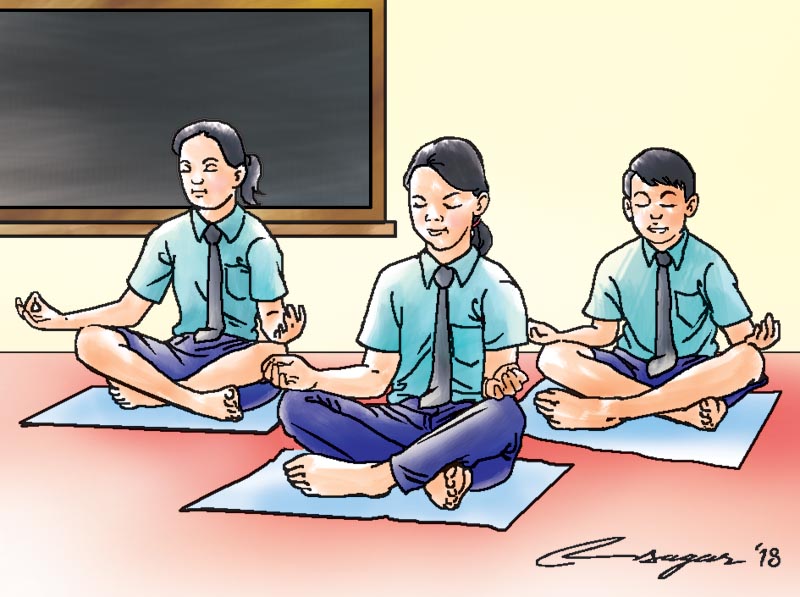Yoga in schools: Helps kids with anxiety
Researches have shown yoga in schools may be a great benefit to children’s mental health. Therefore, integrating yoga into school curriculum becomes a viable option to address emerging emotional and physical health issues in children
A voluminous body of research work asserts that children are increasingly becoming victims of stress-related physical and emotional health problems. Prof S Khalasha, Assistant Professor of Medicine at Harvard Medical School, has observed a plethora of stress-related physical, emotional, behavioural and academic issues in adolescents. Likewise, American Psychology Association states that stress takes a huge toll on the physical and emotional health of children and adolescents.
Children and adolescents around the world today are growing up to be physically and emotionally fragile individuals. In extreme cases, in the developed countries like USA, incidents of violence are being reported in which teenager students are involved in carrying out mass shootings. For example, according to a CNN report, there has been, on average, one school shooting every week this year in 2018.
Against this backdrop, what is more, troubling is: parents often tend to underestimate the level of stress their children experience and the impact their own stress has on their children. Additionally, children and adolescents cannot always express their problems correctly; rather they do so through their behaviour. Managing these problems are challenging for these young minds. As a society, it’s high time we pondered seriously over this pressing matter and ensured that our children grow up with the best emotional and physical health to become better human beings who can contribute to make society a better place.
On the brighter side, addressing this issue might not be as difficult and require as much resource as we might anticipate.
According to the United Nations, children and adolescents around the world spend an average of 10 to 15 years in school, making schools as platforms that hold tremendous potential to teach healthy habits in children and adolescents from an early age to promote their health and well-being. Meanwhile, several research works have focused on the health benefits of yoga as well, and their positive impacts on holistic health have been undisputed. Therefore, integrating yoga into school curriculum becomes a viable option to address emerging emotional and physical health issues in children and adolescents.
Many countries have indeed already incorporated yoga in the school curriculum, highlighting the importance of yoga.
The physical and psychological growths do not mature together. When children reach the age of eight, the pineal gland starts regressing and when the process has advanced to a certain degree, the sex hormones start to function in the body. During this time, physical growth outpaces the mental growth – that is growth in relation to brain, nervous system and endocrine system. This variation in the growth of mind and body parts is the primary basis for inherent problems in students. After children cross 10 years of age, more challenges appear at physical, mental and emotional level. Furthermore, when sex hormones start to secrete in girls -- for instance the mammary glands -- the ovaries and uterus start to function. Now if the pineal gland is out of the picture too early, the whole confusion starts at the wrong time.
The child becomes restless because he/she is not physically ready to express these new developments. With no knowledge to understand these conflicting bodily changes and manage their behaviour, students tend to take up risk behaviour. These often include wrong friend circle, drug abuse, smoking, consuming junk food, fighting, uncontrolled and speed driving, unsafe sexual activities, infatuation, early marriage, arrogance and suicidal proclivity among others. Psychologists have related, among others, these bodily changes in adolescents as a transitional period of life.
Yoga has the potential to balance this unbalanced growth of body and mind. The pineal and pituitary glands are very important glands. In yoga, it is known as Ajna (third eye) chakra, situated in the brain at the top of the medulla oblongata. It is a very small gland and acts like a lock. The moment the regression of the pineal gland is complete, the emotional growth becomes rapid and the child finds it difficult to adjust. But if we delayed emotional growth in relation to physical growth in students, or if we helped them balance both growths, the child’s stability is enhanced greatly. This is why during the ancient Gurukul system of education students were introduced to yoga at the age of eight.
The Vedic tradition has a ceremony for students of this age in which they are taught various portions of yoga to tackle the very unbalanced growth of brain hormones and body hormones.
By balancing the growth of body and mind, yoga brings positive effects on mind and body, as found by various researches. So, in order to solve the various problems of schoolchildren, and to reduce their risk behaviours, yoga should be incorporated into the school curriculum, and students should be encouraged to practise yoga regularly and meditation at least 45 minutes daily. Schools should give equal importance to yoga as other subjects and the government should implement yoga in the curriculum so that children practice it and get results in their life.
Pant, former national player of boxing and martial arts, teaches yoga at schools






